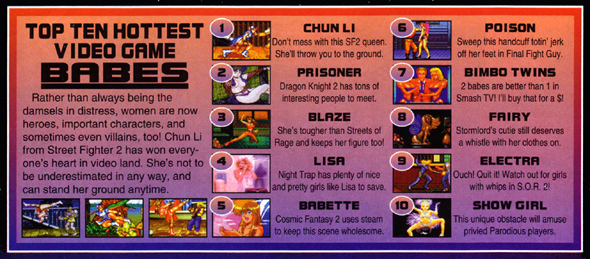Cyborgs Ain't Ladies
Attention has been called many times before to the less-than-subtle sexism found in the video game industry, and it's damned hard to refute that. Rarely do we see a female character on a game's cover without her revealing some degree of T and/or A, and many titles make the shocking choice to not even feature women at all. Granted, we can always bring up examples like Chris Lightfellow from Suikoden III or Metroid's perennial heroine, but in such discussions it's only a matter of time until someone posts shots of 8-bit Samus in her three-pixel bikini and makes us feel sick of the life we've led.
As we heap all due criticism on the present state of videogames, we also might examine the ways in which the medium has changed and perhaps even improved its depictions of women in the past ten years. Consider this, which we swear was actually published in the February 1993 edition of Electronic Gaming Monthly.

For starters, note that four of the magazine's choices don't even have names, or even places of note in their respective games. “Bimbo Twins” and “Fairy” are mere scenery, while “Show Girl” is a level boss; in other words, moving scenery. The fairy, who was naked in Razorsoft's original version of StormLord, is just a background statue, so instead of praising a pixelly abstraction of a real woman, the writers are praising a pixelly abstraction of a statue that's supposed to resemble a real woman. How avant-garde.
And despite the introductory conjecture that women aren't always “damsels in distress,” the descriptively named “Prisoner” was only a victim to be rescued, and Dragon Knight 2, being a porn title from Japanese PCs, didn't allow players to save the imperiled women until after they viewed extended sex-torture scenes. I'm sure that she's an “important character,” though.
Among the examples on the list, in fact, only Chun-Li and Babette (and possibly Blaze) can truly be called “characters” in the sense that they have motivations, personalities, and reasons for existing other than blunt objectification. Of course, we have picks such as Poison and Electra, who prove as empowered as a pixel-made woman can be while wearing leather or cutoffs and serving as a punching bag for the player's character (here we're setting aside the insane palaver over whether or not Poison ever had a penis, because it's impolite to theorize). And let's not forget Lisa from Night Trap, which proved once and for all that video games can give women all of the mystique and nuance of starlets from classics like The Slumber Party Massacre and Terror Toons.
Then there's the writing itself, which is lousy even for the sixth grade reading level that EGM and other gaming magazines chose throughout the early 1990s. Nothing gives Chun-Li her due credit more than the proclamation that she's “won everyone's hearts in video land.” What the heck is “video land” supposed to be, anyway? All it does is conjure up images of some seedy non-chain movie rental store, or perhaps the setting of Captain N: The Game Master.
At this point, knowledgeable fans of old-school gaming will probably point out that the magazine's insulting prate ignores a handful of female characters who were shown in a better light, in games such Alisia Dragoon or Dragon Warrior IV or Valis III. And yet it's tough to name ten dignified video game women from around 1993, leaving us with the grudging admission that, stupid as it is, EGM's rundown of “babes” is an accurate reflection of its era.
This, however, isn't the limit of the 16-bit epoch's staunch gaming feminism.
Part 2: The Non-Lady Cyborg
|